


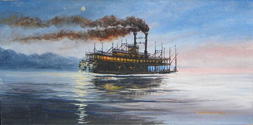

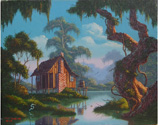
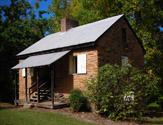









Magnolia Eden
Daffodils for the Deep South
By Sara Van Beck
While daffodils are usually considered a northern thing, historic daffodils have been planted by southerners, both city and country folk, since the 1800s. This overview is based upon research and conversations with southern daffodil growers, and reflects their experiences and recommendations. Suggested background reading includes information provided online by the American Daffodil Society, Georgia Daffodil Society and Florida Daffodil Society as well as the various books and publications listed in this article's bibliography.
While daffodils are usually considered a northern thing, historic daffodils have been planted by southerners, both city and country folk, since the 1800s. This overview is based upon research and conversations with southern daffodil growers, and reflects their experiences and recommendations. Suggested background reading includes information provided online by the American Daffodil Society, Georgia Daffodil Society and Florida Daffodil Society as well as the various books and publications listed in this article's bibliography.
In the world of daffodils (of which all comprise the genus Narcissus), individual varieties are broken up into thirteen divisions; the first twelve are for human-created hybrid culitvars, whilst the thirteenth is reserved for all species and wild (or "intersectional") hybrids. The twelve divisions are mostly based upon the species group from which the hybrids are derived (like jonquils!), with a few divisions as "catch-alls" (For example, all doubles are lumped together irrespective of lineage.) Rather than re-invent the wheel, and more importantly for the lovely images, please refer to the American Daffodil Society's website page Daffodil Divisions and Cultivars. All daffodils are described in a standardized short-hand that specifies its division, then petal color, then cup color, as so: 1Y-Y (would be a trumpet daffodil with yellow petals and yellow cup) or 3W-WWO (is a small cup flower, white petals and a white cup with just an orange ring at its rim). This gives one a quick sketch of a flower by its general form and coloration.
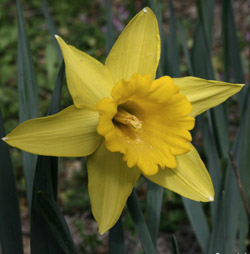
'Flower Carpet' 1Y-Y
Daffodils are like any other plant---they are the product of where they evolved. So, understanding that most daffodils originated from the relatively dry, mountainous Mediterranean region and adapted to the weather on the side of the mountain from where they came, and the spring snow melt, helps explain why different types of daffodils prefer different conditions. Poets came from the top of the mountains in the alpine grass meadows; cyclamineous came from the cool, slightly damp gritty mountains of Portugal; and true tazettas (the paperwhite clan) came from the bottom of the mountains alongside the streams and coastline. Jonquils, some of the oldest daffodils, came from lower elevation areas of very dry summers. Many species are from the African side of the Mediterranean.
Amongst southern daffodilians (those who seriously grow daffodils for show) in the Deep South, there are some points of concensus. Most pinks are roundly denounced as muddy if not just ugly, and reds bemoaned as dark orange. Doubles are considered problematic, requiring more water than average; the same holds true for many cyclamineous varieties.
If a cultivar doesn't perform well for you, try a different location before giving up on it. It may be that you found a hot spot instead of a cool one, or the drainage isn't adequate. Also, some cultivars like drier conditions while others like things more humid. (This applies to "true tazettas" down at the coast.)
If you have doubts, get your soil tested! Don't add chemicals or amendments just because you always fertilize everything. Regular fertilizers do not always comprise the correct formulation, and many heirlooms do NOT like much of any fertilizer at all.
Most daffodils need good drainage; few like really wet feet (though jonquils do during their growing season). Summer dormancy soil temperatures are another story. Some need cool summer soils (cyclamineous, poets, small cups), while jonquils thrive with a baking hot summer. Overplanting with annuals that absorb excess water and fertilizer are recommended. Do not plant your daffodils near heavy feeders like roses and daylilies - their fertilizer will rot the daffodils.
If you have heavy clay, you can amend it with river sand to improve porosity; if you have sand, chopped leaves are the recommended amendment. DO NOT USE MANURE OR MUSHROOM COMPOST. Heavy, rich compost leads to a quick case of summer bulb rot! Also, when you amend clay, ensure you dig much deeper than the bulbs' root systems will travel - do not create a bowl that holds water and thus promotes rot. Chopped leaves are the recommended mulch - the weight is light enough not to smother emerging foliage, and the nutrients released by their slow decay function as slow-release fertilizer in good proportions for what daffodils desire.
More daffodils and divisions will thrive the further north you are than down at the coast; the great daffodil divide seems to be north of the Fall Line, really the beginnings of the Appalacian foothills. For all regions, particularly for novice gardeners, only midseason and earlier bloomers are recommended (no later than early April). Late midseason and late-blooming flowers are very likely to get hit by early spring heatwaves, even sometimes into Zone 6 (don't fiddle with them if you're in Zone 7). If you just have to have one, plant in a spot with afternoon shade and be prepared to water heavily (a problem if you're under watering restrictions). As springs warm up, or heat waves come earlier, gardeners will likely end up relying upon earlier season flowers. Further south to Zone 8a, gardeners must rely upon early season and basal rot resistant parentage in cultivar selection. Pinks, reds, many oranges and whites need light shade to keep from heat stroking, color fading or both. Cultivars with red rims often quickly sunburn on the rim.
Division 1 (Trumpet Daffodils)
Across much of the South, most yellow trumpets perform well. All-whites are problematic as many easily rot. Pinks and bicolors (yellow and white) and reverse bicolors usually performer poorly, particularly in lower Zone 7b to 8a. By Zone 8b, no pinks survive, only one or two historic white trumpets are recommended (but they are not floriferous), and even few yellow trumpets thrive ('Flower Carpet' is top of the list, followed by 'Rinjveld's Early Sensation'). All trumpets prefer a slightly acidic soil, and further south light afternoon shade helps the foliage stay green longer (to build up the bulb for next season's flowering). Pinks and whites need light in the afternoon to keep from frying, and for good drainage. For one's first all-whites, plant 'Beersheba' and 'Mount Hood'; for a bicolor trumpet plant her majesty 'Empress' - an oldie but very robust. Pinks and show bicolors, as relative new inventions in daffodil history, seem to need a richer soil and more attention to watering. In Zone 8a, deep planting of 10" provides a more even, cooler soil temperature.
Amongst southern daffodilians (those who seriously grow daffodils for show) in the Deep South, there are some points of concensus. Most pinks are roundly denounced as muddy if not just ugly, and reds bemoaned as dark orange. Doubles are considered problematic, requiring more water than average; the same holds true for many cyclamineous varieties.
If a cultivar doesn't perform well for you, try a different location before giving up on it. It may be that you found a hot spot instead of a cool one, or the drainage isn't adequate. Also, some cultivars like drier conditions while others like things more humid. (This applies to "true tazettas" down at the coast.)
If you have doubts, get your soil tested! Don't add chemicals or amendments just because you always fertilize everything. Regular fertilizers do not always comprise the correct formulation, and many heirlooms do NOT like much of any fertilizer at all.
Most daffodils need good drainage; few like really wet feet (though jonquils do during their growing season). Summer dormancy soil temperatures are another story. Some need cool summer soils (cyclamineous, poets, small cups), while jonquils thrive with a baking hot summer. Overplanting with annuals that absorb excess water and fertilizer are recommended. Do not plant your daffodils near heavy feeders like roses and daylilies - their fertilizer will rot the daffodils.
If you have heavy clay, you can amend it with river sand to improve porosity; if you have sand, chopped leaves are the recommended amendment. DO NOT USE MANURE OR MUSHROOM COMPOST. Heavy, rich compost leads to a quick case of summer bulb rot! Also, when you amend clay, ensure you dig much deeper than the bulbs' root systems will travel - do not create a bowl that holds water and thus promotes rot. Chopped leaves are the recommended mulch - the weight is light enough not to smother emerging foliage, and the nutrients released by their slow decay function as slow-release fertilizer in good proportions for what daffodils desire.
More daffodils and divisions will thrive the further north you are than down at the coast; the great daffodil divide seems to be north of the Fall Line, really the beginnings of the Appalacian foothills. For all regions, particularly for novice gardeners, only midseason and earlier bloomers are recommended (no later than early April). Late midseason and late-blooming flowers are very likely to get hit by early spring heatwaves, even sometimes into Zone 6 (don't fiddle with them if you're in Zone 7). If you just have to have one, plant in a spot with afternoon shade and be prepared to water heavily (a problem if you're under watering restrictions). As springs warm up, or heat waves come earlier, gardeners will likely end up relying upon earlier season flowers. Further south to Zone 8a, gardeners must rely upon early season and basal rot resistant parentage in cultivar selection. Pinks, reds, many oranges and whites need light shade to keep from heat stroking, color fading or both. Cultivars with red rims often quickly sunburn on the rim.
Division 1 (Trumpet Daffodils)
Across much of the South, most yellow trumpets perform well. All-whites are problematic as many easily rot. Pinks and bicolors (yellow and white) and reverse bicolors usually performer poorly, particularly in lower Zone 7b to 8a. By Zone 8b, no pinks survive, only one or two historic white trumpets are recommended (but they are not floriferous), and even few yellow trumpets thrive ('Flower Carpet' is top of the list, followed by 'Rinjveld's Early Sensation'). All trumpets prefer a slightly acidic soil, and further south light afternoon shade helps the foliage stay green longer (to build up the bulb for next season's flowering). Pinks and whites need light in the afternoon to keep from frying, and for good drainage. For one's first all-whites, plant 'Beersheba' and 'Mount Hood'; for a bicolor trumpet plant her majesty 'Empress' - an oldie but very robust. Pinks and show bicolors, as relative new inventions in daffodil history, seem to need a richer soil and more attention to watering. In Zone 8a, deep planting of 10" provides a more even, cooler soil temperature.
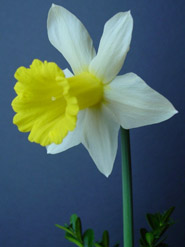
Recommended Cultivars:
'At Dawning' 1Y-P, 'Ballyarnette' 1Y-Y, 'Beersheba' 1W-W, 'Bravoure' 1W-Y, 'Broughshane' 1W-W, 'Cantatrice' 1W-W, 'Chinese Coral' 1W-P, 'Compute' 1W-Y, 'Denali' 1W-W, 'Empress' 1W-Y, 'Flower Carpet' 1Y-Y, 'General Patton' 1W-Y, 'Gin and Lime' 1Y-WWY (mixed reports), 'Glenfarclas' 1Y-O, 'Golden Rapture' 1Y-Y, 'Golden Spur' 1Y-Y, 'High Sierra' 1W-W, 'Honeybird' 1Y-W, 'Kingscourt' 1Y-Y, 'Lime Chiffon' 1Y-GWW, 'Little Gem' 1Y-Y, 'Lunar Sea' 1Y-W, 'Magnet' 1W-Y, 'Marieke' 1Y-GYY, 'Melorium' 1Y-Y, 'Mount Hood' 1W-W, 'Mrs. Earnest Krelag' 1W-W, 'Nile' 1W-W, 'Northwest' 1W-W, 'Occasionally' 1W-Y, 'Oklahoma' 1W-Y, 'Parnell's Knob' 1Y-Y, 'Pay Day' 1YYW-W, 'Pink Silk' 1W-P, 'Queen of Bicolors' 1W-Y, 'Rashee' 1W-W, 'Rosey Trumpet' 1W-P, 'Sideling Hill' 1Y-Y, 'Spellbinder' 1Y-WWY (mixed reports), 'Uncle Remus' 1Y-O, 'Unsurpassable' 1Y-Y, 'W. P. Milner' 1W-W
'At Dawning' 1Y-P, 'Ballyarnette' 1Y-Y, 'Beersheba' 1W-W, 'Bravoure' 1W-Y, 'Broughshane' 1W-W, 'Cantatrice' 1W-W, 'Chinese Coral' 1W-P, 'Compute' 1W-Y, 'Denali' 1W-W, 'Empress' 1W-Y, 'Flower Carpet' 1Y-Y, 'General Patton' 1W-Y, 'Gin and Lime' 1Y-WWY (mixed reports), 'Glenfarclas' 1Y-O, 'Golden Rapture' 1Y-Y, 'Golden Spur' 1Y-Y, 'High Sierra' 1W-W, 'Honeybird' 1Y-W, 'Kingscourt' 1Y-Y, 'Lime Chiffon' 1Y-GWW, 'Little Gem' 1Y-Y, 'Lunar Sea' 1Y-W, 'Magnet' 1W-Y, 'Marieke' 1Y-GYY, 'Melorium' 1Y-Y, 'Mount Hood' 1W-W, 'Mrs. Earnest Krelag' 1W-W, 'Nile' 1W-W, 'Northwest' 1W-W, 'Occasionally' 1W-Y, 'Oklahoma' 1W-Y, 'Parnell's Knob' 1Y-Y, 'Pay Day' 1YYW-W, 'Pink Silk' 1W-P, 'Queen of Bicolors' 1W-Y, 'Rashee' 1W-W, 'Rosey Trumpet' 1W-P, 'Sideling Hill' 1Y-Y, 'Spellbinder' 1Y-WWY (mixed reports), 'Uncle Remus' 1Y-O, 'Unsurpassable' 1Y-Y, 'W. P. Milner' 1W-W
'Empress' 1W-Y
Division 2 (Large-Cupped Daffodils)
The workhorse for many southern gardens alongside jonquils, this division provides many flowers as far south as Zone 8b. The same rules for whites, bicolors and pinks trumpets apply to Diviosn 2 flowers (drainage, light shade, slightly richer soil); they may also prefer a shaded soil in the summer to keep the temperature down (so, overplanted with annuals, or well-mulched). However, at least one pink---'Mrs. R. O. Backhouse---blooms as far south as Zone 8b, and is often considered the first true pink to be hybridized. If you live in Zone 7 or further south, the more cold weather improves the saturation of color in pinks, oranges and reds. Whites can be problematic, getting mixed reviews across the South - one that does well for one person tends to die out on another. Reverse bicolors can have rot problems into Zone 8, and should be planted in well-drained, slightly rich soils.
The workhorse for many southern gardens alongside jonquils, this division provides many flowers as far south as Zone 8b. The same rules for whites, bicolors and pinks trumpets apply to Diviosn 2 flowers (drainage, light shade, slightly richer soil); they may also prefer a shaded soil in the summer to keep the temperature down (so, overplanted with annuals, or well-mulched). However, at least one pink---'Mrs. R. O. Backhouse---blooms as far south as Zone 8b, and is often considered the first true pink to be hybridized. If you live in Zone 7 or further south, the more cold weather improves the saturation of color in pinks, oranges and reds. Whites can be problematic, getting mixed reviews across the South - one that does well for one person tends to die out on another. Reverse bicolors can have rot problems into Zone 8, and should be planted in well-drained, slightly rich soils.
Recommended Cultivars:
Pinks
'Dove Song' 2W-WWP, 'Fragrant Rose' 2W-GPP, 'Pink China' 2W-P, 'Pink Satin' 2W-P, 'Precedent' 2W-P, 'Rainbow' 2W-WWP, 'Silent Pink' 2W-P
For Zone 8a: 'Accent' 2W-P, 'Mrs. R. O Backhouse' 2W-P, 'Pink Charm' 2W-WWP
Reds
'Distant Drums' 2Y-R, 'Irish Fire' 2Y-R, 'Loch Hope' 2Y-R, 'Loch Stac' 2Y-R, 'Paricutin' 2Y-R, 'Red Aria' 2O-R, 'Shining Light' 2Y-R
Reverse Bicolors
'Binkie'2Y-W, 'Century' 2Y-WWY, 'Charter' 2Y-WWY, 'Chiloquin' 1Y-W, 'Kernow' 2Y-WWY, 'Limeade' 2Y-W, 'Pastorale' 2Y-WWY, 'Pengarth' 2YYW-WWY, 'Suede' 2Y-W
Whites
'Alaskan Forest' 2W-W, 'Bloemindaal' 2W-W, 'Broomhill' 2W-W, 'Canisp' 2W-W, 'Crystal Blanc' 2W-GWW, 'Homestead' 2W-W, 'River Queen' 2W-W, 'Stainless' 2W-W (mixed reports), 'Stoke Charity' 2W-W
Pinks
'Dove Song' 2W-WWP, 'Fragrant Rose' 2W-GPP, 'Pink China' 2W-P, 'Pink Satin' 2W-P, 'Precedent' 2W-P, 'Rainbow' 2W-WWP, 'Silent Pink' 2W-P
For Zone 8a: 'Accent' 2W-P, 'Mrs. R. O Backhouse' 2W-P, 'Pink Charm' 2W-WWP
Reds
'Distant Drums' 2Y-R, 'Irish Fire' 2Y-R, 'Loch Hope' 2Y-R, 'Loch Stac' 2Y-R, 'Paricutin' 2Y-R, 'Red Aria' 2O-R, 'Shining Light' 2Y-R
Reverse Bicolors
'Binkie'2Y-W, 'Century' 2Y-WWY, 'Charter' 2Y-WWY, 'Chiloquin' 1Y-W, 'Kernow' 2Y-WWY, 'Limeade' 2Y-W, 'Pastorale' 2Y-WWY, 'Pengarth' 2YYW-WWY, 'Suede' 2Y-W
Whites
'Alaskan Forest' 2W-W, 'Bloemindaal' 2W-W, 'Broomhill' 2W-W, 'Canisp' 2W-W, 'Crystal Blanc' 2W-GWW, 'Homestead' 2W-W, 'River Queen' 2W-W, 'Stainless' 2W-W (mixed reports), 'Stoke Charity' 2W-W
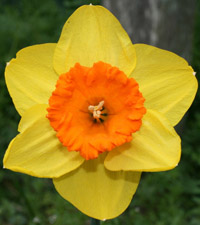
'Distant Drums' 2Y-R
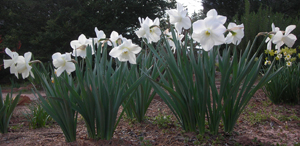
'Stoke Charity' 2W-W
Division 3 (Small-Cupped Daffodils)
These lovely flowers are derived from poet daffodils, and many a Division 3 flower is bred from two poets that happened to produce an offspring without the signature red ring. It also means that many are late season bloomers or late midseason. Many with rim coloration can quickly burn in the spring heat, so all should be planted in locations with some light shade. Some all-whites are particularly poor performers. Few small cups thrive in Zone 8, but many are happy by Zone 7a and very happy into Zone 6b. 'Barrett Browning' can be fickle, doing well in some Zone 8 gardens while consistently not performing in some Zone 7 gardens.
These lovely flowers are derived from poet daffodils, and many a Division 3 flower is bred from two poets that happened to produce an offspring without the signature red ring. It also means that many are late season bloomers or late midseason. Many with rim coloration can quickly burn in the spring heat, so all should be planted in locations with some light shade. Some all-whites are particularly poor performers. Few small cups thrive in Zone 8, but many are happy by Zone 7a and very happy into Zone 6b. 'Barrett Browning' can be fickle, doing well in some Zone 8 gardens while consistently not performing in some Zone 7 gardens.
Recommended Cultivars:
'Aflame' 3W-YOO, 'Aircastle' 3W-Y, 'Barrett Browning' 3WWY-O, 'Cairntoul' 3W-YOO, 'Cedar Hills' 3W-GYY, 'Collector's Choice' 3W-GOR, 'Doctor Hugh' 3W-GOO, 'Dream Castle' 3W-W, 'Dreamlight' 3W-GWR, 'Edward Buxton' 3Y-YYO, 'First Formal' 3W-YWP, 'Glenwherry' 3W-R, 'Gossamer' 3W-YYP, 'Irish Splendour' 3W-R, 'Lalique' 3Y-GYY, 'Limberlost' 3W-YYW, 'Limerick' 3W-R, 'Limey Circle' 3W-WWY, 'Merlin' 3W-YYR, 'Merry King' 3Y-R, 'Moon Tide' 3Y-YOO, 'New Penny' 3Y-Y, 'Palmira' 3W-YRR, 'Perimeter' 3Y-YYO, 'Polar Ice' 3W-W, 'Queen of the North' 3W-Y, 'Riverdell' 3W-GYY, 'Sabine Hay' 3O-R, 'Seagull' 3W-Y, 'Snow Gem' 3W-O, 'Suave' 3Y-Y, 'Sunapee' 3Y-YYR, 'Tranquil Morn' 3W-W, 'Trelay' 3Y-OOR, 'Triple Crown' 3Y-GYR, 'White Lady' 3W-Y, 'Winged Flight' 3W-GYR
'Aflame' 3W-YOO, 'Aircastle' 3W-Y, 'Barrett Browning' 3WWY-O, 'Cairntoul' 3W-YOO, 'Cedar Hills' 3W-GYY, 'Collector's Choice' 3W-GOR, 'Doctor Hugh' 3W-GOO, 'Dream Castle' 3W-W, 'Dreamlight' 3W-GWR, 'Edward Buxton' 3Y-YYO, 'First Formal' 3W-YWP, 'Glenwherry' 3W-R, 'Gossamer' 3W-YYP, 'Irish Splendour' 3W-R, 'Lalique' 3Y-GYY, 'Limberlost' 3W-YYW, 'Limerick' 3W-R, 'Limey Circle' 3W-WWY, 'Merlin' 3W-YYR, 'Merry King' 3Y-R, 'Moon Tide' 3Y-YOO, 'New Penny' 3Y-Y, 'Palmira' 3W-YRR, 'Perimeter' 3Y-YYO, 'Polar Ice' 3W-W, 'Queen of the North' 3W-Y, 'Riverdell' 3W-GYY, 'Sabine Hay' 3O-R, 'Seagull' 3W-Y, 'Snow Gem' 3W-O, 'Suave' 3Y-Y, 'Sunapee' 3Y-YYR, 'Tranquil Morn' 3W-W, 'Trelay' 3Y-OOR, 'Triple Crown' 3Y-GYR, 'White Lady' 3W-Y, 'Winged Flight' 3W-GYR
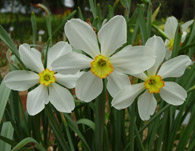
'Seagull' 3W-Y
Division 4 (Double Daffodils)
All doubles, from every division, are lumped into Division 4, which can be misleading. Early to midseason season bloomers, tazetta and very old historic doubles perform best. All doubles require regular watering - more water than standards and more often, to keep all the petals with sufficient tugor pressure to open properly. The multitude of petals are very susceptible to yo-yo'ing temperatures, and even minor heat waves are known to "blast" doubles - the buds simply dry up in their protective sheathing. All standard doubles prefer a clay soil to sand even cool springs, and many prefer not to be crowded. Into Zone 8, double tazettas are the recommended doubles, with the exception of two old heirloom standbys - 'Orange Phoenix' (often called "Butter and Eggs") and 'Telamonious Plenus' (often called by its old Dutch name "Van Sion"). Interestingly, where ever you go in the South, there's a "Butter and Eggs," but what the flower is that is "Butter and Eggs" is different! In some places it is 'Orange Phoenix', others its 'Telamonius Plenus'.
All doubles, from every division, are lumped into Division 4, which can be misleading. Early to midseason season bloomers, tazetta and very old historic doubles perform best. All doubles require regular watering - more water than standards and more often, to keep all the petals with sufficient tugor pressure to open properly. The multitude of petals are very susceptible to yo-yo'ing temperatures, and even minor heat waves are known to "blast" doubles - the buds simply dry up in their protective sheathing. All standard doubles prefer a clay soil to sand even cool springs, and many prefer not to be crowded. Into Zone 8, double tazettas are the recommended doubles, with the exception of two old heirloom standbys - 'Orange Phoenix' (often called "Butter and Eggs") and 'Telamonious Plenus' (often called by its old Dutch name "Van Sion"). Interestingly, where ever you go in the South, there's a "Butter and Eggs," but what the flower is that is "Butter and Eggs" is different! In some places it is 'Orange Phoenix', others its 'Telamonius Plenus'.
Recommended Cultivars:
Standards
'Crackington' 4Y-O, 'Gay Ruler' 4Y-O, 'Ice Diamond' 4W-W, 'Sugar Loaf' 4W-P*, 'Sunheat' 4Y-O, 'Tahiti' 4Y-O, 'Tamar Fire' 4Y-R*, 'Texas' 4Y-O (mixed reports), 'Tonga' 4Y-R*, 'White Lion' 4W-W (mixed reports), 'White Marvel' 4W-W
Double Tazettas
'Abba' 4W-O, 'Bridal Crown' 4W-Y, 'Cheerfulness' 4W-Y, 'Erlicheer' 4W-W, 'Sir Winston Churchill' 4W-O*, 'Yellow Cheerfulness' 4Y-Y
Historics
'Butter and Eggs' 4Y-O, 'Double Campernelle' 4Y-Y, 'Flore Pleno' 4Y-Y, 'Orange Phoenix' 4W-O, 'Rip Van Winkle' 4Y-Y, 'Telamonius Plenus' 4Y-Y
Standards
'Crackington' 4Y-O, 'Gay Ruler' 4Y-O, 'Ice Diamond' 4W-W, 'Sugar Loaf' 4W-P*, 'Sunheat' 4Y-O, 'Tahiti' 4Y-O, 'Tamar Fire' 4Y-R*, 'Texas' 4Y-O (mixed reports), 'Tonga' 4Y-R*, 'White Lion' 4W-W (mixed reports), 'White Marvel' 4W-W
Double Tazettas
'Abba' 4W-O, 'Bridal Crown' 4W-Y, 'Cheerfulness' 4W-Y, 'Erlicheer' 4W-W, 'Sir Winston Churchill' 4W-O*, 'Yellow Cheerfulness' 4Y-Y
Historics
'Butter and Eggs' 4Y-O, 'Double Campernelle' 4Y-Y, 'Flore Pleno' 4Y-Y, 'Orange Phoenix' 4W-O, 'Rip Van Winkle' 4Y-Y, 'Telamonius Plenus' 4Y-Y
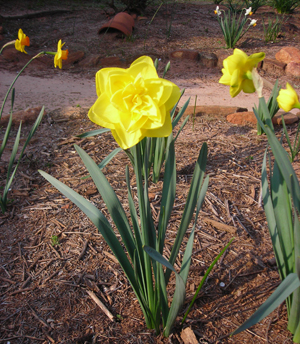
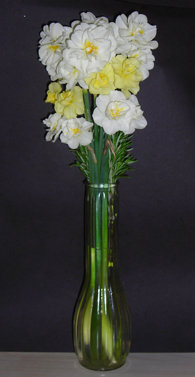
'Crackington' 4Y-O
Vase containing 'Sir Winston Churchill' 4W-O (top), 'Yellow Cheerfulness' 4Y-Y (middle) and 'Cheerfulness' 4W-Y (bottom)
Division 5 (Triandrus Daffodils)
Considered to do well across the region, some growers comment triandrus often only produce one flower per stem. Light shade is suggested (some varieties seem to prefer partial shade), as well as acidic (not alkaline) soil. Some authors note triandrus prefer a cooler soil over the summer. Further, some suggest "sharp drainage," and so sandier soils may be preferred. As originating from the hillsides of Spain, select a drier summer location with good drainage. Provide some winter shelter in more northern reaches.
Considered to do well across the region, some growers comment triandrus often only produce one flower per stem. Light shade is suggested (some varieties seem to prefer partial shade), as well as acidic (not alkaline) soil. Some authors note triandrus prefer a cooler soil over the summer. Further, some suggest "sharp drainage," and so sandier soils may be preferred. As originating from the hillsides of Spain, select a drier summer location with good drainage. Provide some winter shelter in more northern reaches.
Recommended Cultivars:
'Angel's Breath' 5Y-Y (mixed reports), 'April Tears' 5Y-Y (mixed reports), 'Frosty Morn' 5W-W, 'Harmony Bells' 5Y-Y, 'Ice Wings' 5W-W, 'Jovial' 5Y-O, 'Kite' 5W-Y, 'Lapwing' 5W-Y, 'Lavalier' 5YYW-W, 'Lemon Drops' 5Y-Y, 'Liberty Bells' 5Y-Y, 'Mission Bells' 5W-W, 'Moonshine' 5W-W, 'Niveth' 5W-W, 'Petrel' 5W-W, 'Ringing Bells' 5W-W, 'Rippling Waters' 5W-W, 'Russian Chimes' 5W-W, 'Saberwing' 5W-GWW, 'Samba' 5Y-O, 'Shot Silk' 5W-W, 'Sidhe' 5Y-Y, 'Spring Chimes' 5W-W, 'Swift Current' 5W-P, 'Thalia' 5W-W, 'Tresamble' 5W-W, 'Tuesday's Child' 5W-Y
'Angel's Breath' 5Y-Y (mixed reports), 'April Tears' 5Y-Y (mixed reports), 'Frosty Morn' 5W-W, 'Harmony Bells' 5Y-Y, 'Ice Wings' 5W-W, 'Jovial' 5Y-O, 'Kite' 5W-Y, 'Lapwing' 5W-Y, 'Lavalier' 5YYW-W, 'Lemon Drops' 5Y-Y, 'Liberty Bells' 5Y-Y, 'Mission Bells' 5W-W, 'Moonshine' 5W-W, 'Niveth' 5W-W, 'Petrel' 5W-W, 'Ringing Bells' 5W-W, 'Rippling Waters' 5W-W, 'Russian Chimes' 5W-W, 'Saberwing' 5W-GWW, 'Samba' 5Y-O, 'Shot Silk' 5W-W, 'Sidhe' 5Y-Y, 'Spring Chimes' 5W-W, 'Swift Current' 5W-P, 'Thalia' 5W-W, 'Tresamble' 5W-W, 'Tuesday's Child' 5W-Y
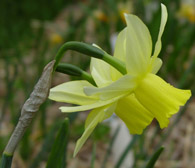
'Lemon Drops' 5Y-Y
Division 6 (Cyclamineus Daffodils)
Purportedly these flowers do not care for heavy clay soils, so raised beds of sand or decomposed granite are often recommended (hearkening back to their Portuguese mountain homeland?). Cyclamineus prefer light afternoon shade, damp conditions, acid soils and cool (and damp?) summer soils. Small varieties seem to perform well in leafier soils, with watering and partial shade. Earlier bloomers are best. The pinks are rarely pink, described as "not very distinctive."
Purportedly these flowers do not care for heavy clay soils, so raised beds of sand or decomposed granite are often recommended (hearkening back to their Portuguese mountain homeland?). Cyclamineus prefer light afternoon shade, damp conditions, acid soils and cool (and damp?) summer soils. Small varieties seem to perform well in leafier soils, with watering and partial shade. Earlier bloomers are best. The pinks are rarely pink, described as "not very distinctive."
Recommended Cultivars:
Beryl' 6W-YYO, 'Bushtit' 6Y-Y, 'Continga' 6W-P, 'Charity May' 6Y-Y, 'Delta Wings' 6W-P, 'Dove Wings' 6W-Y (mixed reports), 'Elizabeth Ann' 6W-GWP, 'Estrellita' 6Y-Y, 'February Gold' 6Y-Y, 'Flint Arrow' 6Y-O, 'Hummingbird' 6Y-Y (mixed reports), 'Itzim' 6Y-R, 'Jenny' 6W-W, 'Jetfire' 6Y-R (likes soil a bit drier), 'Little Witch' 6Y-Y, 'March Sunshine' 6Y-Y, 'Peeping Tom' 6Y-Y, 'Phalarope' 6W-Y, 'Rapture' 6Y-Y, 'Satellite' 6Y-O, 'Skater's Waltz' 6Y-Y, 'Surfside' 6W-Y, 'Swift Arrow' 6Y-Y (mixed reports), 'The Alliance' 6Y-Y, 'Toby' 6Y-Y, 'Tracey' 6W-W, 'Trena' 6W-Y (mixed reports), 'Willet' 6Y-Y, 'Winged Victory' 6W-Y
Beryl' 6W-YYO, 'Bushtit' 6Y-Y, 'Continga' 6W-P, 'Charity May' 6Y-Y, 'Delta Wings' 6W-P, 'Dove Wings' 6W-Y (mixed reports), 'Elizabeth Ann' 6W-GWP, 'Estrellita' 6Y-Y, 'February Gold' 6Y-Y, 'Flint Arrow' 6Y-O, 'Hummingbird' 6Y-Y (mixed reports), 'Itzim' 6Y-R, 'Jenny' 6W-W, 'Jetfire' 6Y-R (likes soil a bit drier), 'Little Witch' 6Y-Y, 'March Sunshine' 6Y-Y, 'Peeping Tom' 6Y-Y, 'Phalarope' 6W-Y, 'Rapture' 6Y-Y, 'Satellite' 6Y-O, 'Skater's Waltz' 6Y-Y, 'Surfside' 6W-Y, 'Swift Arrow' 6Y-Y (mixed reports), 'The Alliance' 6Y-Y, 'Toby' 6Y-Y, 'Tracey' 6W-W, 'Trena' 6W-Y (mixed reports), 'Willet' 6Y-Y, 'Winged Victory' 6W-Y
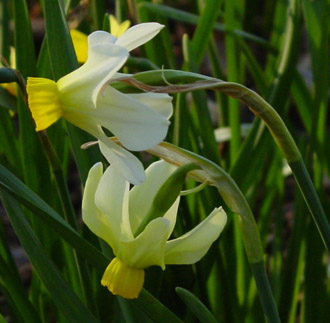
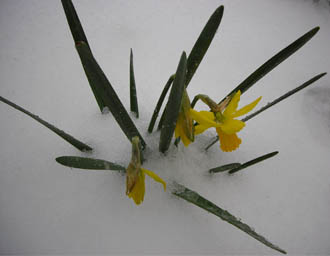
'Beryl' 6W-YYO
'February Gold' 6Y-Y
Division 7 (Jonquil-type Daffodils)
Veritable weeds in comparison to their fussier cousins, jonquils are well suited to the Deep South even if often only producing one floret per stem (particularly into Zone 8). Early and midseason flowers are key. Pink, late midseason and late season bloomers will get blasted by late spring heat waves if not afforded a cool location and afternoon shade. Jonquils are water hogs from the time they sprout until after flowering. A hot summer baking promotes good flowering. Check the soil phosphorous level, as some jonquils seem to prefer a higher phosphate level than others (or, if your jonquils aren't happy, check for a low soil phosphorous level after evaluating for tree shade creep). Early sprouting foliage will need some protection in northern reaches, as stunted foliage sets the bulb back the following year.
Veritable weeds in comparison to their fussier cousins, jonquils are well suited to the Deep South even if often only producing one floret per stem (particularly into Zone 8). Early and midseason flowers are key. Pink, late midseason and late season bloomers will get blasted by late spring heat waves if not afforded a cool location and afternoon shade. Jonquils are water hogs from the time they sprout until after flowering. A hot summer baking promotes good flowering. Check the soil phosphorous level, as some jonquils seem to prefer a higher phosphate level than others (or, if your jonquils aren't happy, check for a low soil phosphorous level after evaluating for tree shade creep). Early sprouting foliage will need some protection in northern reaches, as stunted foliage sets the bulb back the following year.
Recommended Cultivars:
'Bell Song' 7W-P, 'Cherie' 7W-P, 'Intrigue' 7Y-W, 'Kokopelli' 7Y-Y, 'Pink Angel' 7W-GWP, 'Pipit' 7YYW-W, 'Punchline' 7Y-YYP, 'Waterperry' 7W-YPP
'Bell Song' 7W-P, 'Cherie' 7W-P, 'Intrigue' 7Y-W, 'Kokopelli' 7Y-Y, 'Pink Angel' 7W-GWP, 'Pipit' 7YYW-W, 'Punchline' 7Y-YYP, 'Waterperry' 7W-YPP
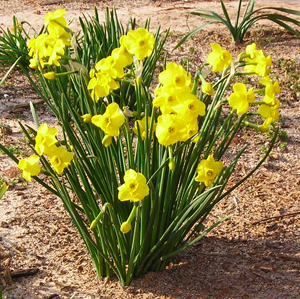
'Kokopelli' 7Y-Y
Division 8 (Tazetta Daffodils)
Tazettas come in two flavors - true and poetaz. In the Deep South, the further north one goes the better the poetaz varieties thrive and the less often cold-tender true tazettas make it. For true tazettas, plant in a full-sun, sheltered location. By Zone 6b, 'Avalanche' gets hit regularly so it is an intermittent bloomer. By Zone 8, many poetaz need light afternoon shade, particularly the later-blooming cultivars. Early sprouting foliage will need some protection in northern reaches, as stunted foliage sets the bulbs back the following year.
Tazettas come in two flavors - true and poetaz. In the Deep South, the further north one goes the better the poetaz varieties thrive and the less often cold-tender true tazettas make it. For true tazettas, plant in a full-sun, sheltered location. By Zone 6b, 'Avalanche' gets hit regularly so it is an intermittent bloomer. By Zone 8, many poetaz need light afternoon shade, particularly the later-blooming cultivars. Early sprouting foliage will need some protection in northern reaches, as stunted foliage sets the bulbs back the following year.
Recommended Cultivars:
'Bright Spangles' 8Y-O, 'Cragford' 8W-O, 'Geranium' 8W-O, 'Grand Primo Citroniere' 8W-Y, 'Grand Soleil d'Or 8Y-O, 'Laurens Koster' 8W-Y
Suitable for Zone 8:
'Avalanche of Gold' 8Y-Y, 'Early Pearl' 8W-Y, 'Grand Soleil d'Or' 8Y-O, 'Scilly White' 8W-W, 'Silver Chimes' 8W-W, 'White Pearl' 8W-W
'Bright Spangles' 8Y-O, 'Cragford' 8W-O, 'Geranium' 8W-O, 'Grand Primo Citroniere' 8W-Y, 'Grand Soleil d'Or 8Y-O, 'Laurens Koster' 8W-Y
Suitable for Zone 8:
'Avalanche of Gold' 8Y-Y, 'Early Pearl' 8W-Y, 'Grand Soleil d'Or' 8Y-O, 'Scilly White' 8W-W, 'Silver Chimes' 8W-W, 'White Pearl' 8W-W
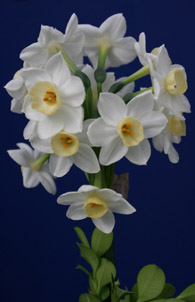
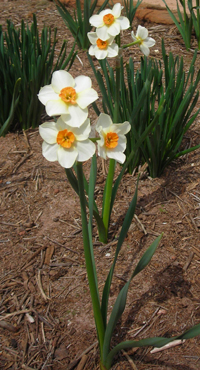
'Grand Primo Citroniere' 8W-Y
'Bright Spangles' 8Y-O
Division 9 (Poeticus Daffodils)
A dubious division at best. Few cultivars are recommended, with 'Actaea' top of the list. As poets tend to have year-round roots, they do not hold up to the Deep South summer heat. Poets can quickly open then fold the same day in early April heat waves. Light shade while growing, regular watering, cool summer soil temperatures and damp summer soils are best (such as under deciduous trees). One grower reported doing well with a very shaded location on a sandy creek bank. Another indicated her trick was to never move them after initial planting. A number of American-bred midseason poets (from the late Meg Yerger of Maryland and Dr. William Bender of Pennsylvania) unfortuntately are not commercially available. One Australian midseason poet is available - 'Ika Jika' 9 W-GYR by Glenbrook Bulb Farm, bred from 'Actaea'. Late season poets include historics, a few American-bred and a number of overseas creations. No poets have yet been identified to satisfactorily repeat bloom in Zone 8a.
A dubious division at best. Few cultivars are recommended, with 'Actaea' top of the list. As poets tend to have year-round roots, they do not hold up to the Deep South summer heat. Poets can quickly open then fold the same day in early April heat waves. Light shade while growing, regular watering, cool summer soil temperatures and damp summer soils are best (such as under deciduous trees). One grower reported doing well with a very shaded location on a sandy creek bank. Another indicated her trick was to never move them after initial planting. A number of American-bred midseason poets (from the late Meg Yerger of Maryland and Dr. William Bender of Pennsylvania) unfortuntately are not commercially available. One Australian midseason poet is available - 'Ika Jika' 9 W-GYR by Glenbrook Bulb Farm, bred from 'Actaea'. Late season poets include historics, a few American-bred and a number of overseas creations. No poets have yet been identified to satisfactorily repeat bloom in Zone 8a.
Recommended Cultivars:
'Actaea' 9 W-YYR, 'Campion' 9W-GYR (mixed reports), 'Ornatus' 9W-YYR, 'Poet's Way' 9W-GYR (mixed reports), N. poeticus var. recurvus
'Actaea' 9 W-YYR, 'Campion' 9W-GYR (mixed reports), 'Ornatus' 9W-YYR, 'Poet's Way' 9W-GYR (mixed reports), N. poeticus var. recurvus
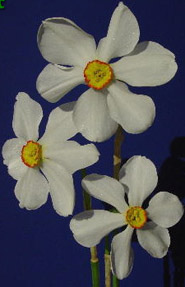
'Actaea' 9W-YYR
Division 10 (Bulbocodium Daffodils)
Despite a paucity of written recommendations, a few bulbocodium are often mentioned, these being earlier bloomers such as 'Fyno'. N. bulbocodium subsp. bulbocodium var. bulbocodium does well in northwest Louisiana, while N. bulbocodium subsp. bulbocodium var. conspicuus grows well in north Florida in both acidic sandy and red clay soils. Generally, bulbocodium prefer a damp soil with good drainage (such as sandy clay), light afternoon shade (for soil moisture) and a dry, baking summer. Some gardeners plant their bulbocodium on slopes for better drainage. Some varieties are uneven in their blooming from year to year. In Zone 8a, some daffodilians grow theirs in pots; 'Smarple' has made it as far south as coastal Georgia.
Despite a paucity of written recommendations, a few bulbocodium are often mentioned, these being earlier bloomers such as 'Fyno'. N. bulbocodium subsp. bulbocodium var. bulbocodium does well in northwest Louisiana, while N. bulbocodium subsp. bulbocodium var. conspicuus grows well in north Florida in both acidic sandy and red clay soils. Generally, bulbocodium prefer a damp soil with good drainage (such as sandy clay), light afternoon shade (for soil moisture) and a dry, baking summer. Some gardeners plant their bulbocodium on slopes for better drainage. Some varieties are uneven in their blooming from year to year. In Zone 8a, some daffodilians grow theirs in pots; 'Smarple' has made it as far south as coastal Georgia.
Recommended Cultivars:
'Fyno' 10W-, 'Mitimoto' 10W-Y, 'Smarple' 10W-W, 'Spoirot' 10W-W
'Fyno' 10W-, 'Mitimoto' 10W-Y, 'Smarple' 10W-W, 'Spoirot' 10W-W
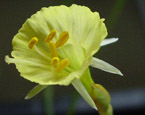
'Mitimoto' 10W-Y
Division 11 (Split Corona Daffodils)
Once considered a poorly performing division, newer hybrids reportedly are more robust. Not noted for withstanding heavy weather, this group's cup color can fade rapidly in full sun. They seem to prefer (require?) a richer soil, good drainage and double-digging to 18" in clay. One coastal Georgian grows 'December Bride' and 'Tripartite'. 'Bosbigal' 11a Y-O and 'Top Hit' 11a Y-Y managed to hold on in upper Zone 8b. By Zone 6b, this division performs quite well. The Mitsch Pink Split Cup Mix came highly recommended as well.
Once considered a poorly performing division, newer hybrids reportedly are more robust. Not noted for withstanding heavy weather, this group's cup color can fade rapidly in full sun. They seem to prefer (require?) a richer soil, good drainage and double-digging to 18" in clay. One coastal Georgian grows 'December Bride' and 'Tripartite'. 'Bosbigal' 11a Y-O and 'Top Hit' 11a Y-Y managed to hold on in upper Zone 8b. By Zone 6b, this division performs quite well. The Mitsch Pink Split Cup Mix came highly recommended as well.
Recommended Cultivars:
'Cassata' 11a W-W, 'Chanterelle' 11aY-Y, 'Colblanc' 11aW-GWW, 'Cool Evening' 11aW-P, 'Cum Laude' 11a W-P, 'December Bride' 11a W-P, 'Delta' 11b W-OYO (repeats in upper Zone 8a), 'Dolly Mollinger' 11bW-O/W, 'Firestreak' 11b W-R/OW (mixed reports), 'Ice Crystal' 11aW-W, 'Love Call' 11aW-OOY, 'Mistral' 11aW-Y, 'Mondragon' 11aY-O, 'Orangery' 11aW-OOY, 'Palmeres' 11aW-P, 'Papillion Blanc' 11bW-W, 'Phantom' 11aW-P (mixed reports), 'Pink Formal' 11a W-P, 'Pink Tango' 11aW-P, 'Printal' 11aW-Y, 'Rosannor Gold' 11aY-Y, 'Shrike' 11aW-P, 'Sorbet' 11bW-Y/OW, 'Tiritomba' 11a Y-O (repeats in Upper Zone 8a), 'Tricollete' 11W-O, 'Trigonometry' 11aW-P, 'Tripartite' 11aY-Y
'Cassata' 11a W-W, 'Chanterelle' 11aY-Y, 'Colblanc' 11aW-GWW, 'Cool Evening' 11aW-P, 'Cum Laude' 11a W-P, 'December Bride' 11a W-P, 'Delta' 11b W-OYO (repeats in upper Zone 8a), 'Dolly Mollinger' 11bW-O/W, 'Firestreak' 11b W-R/OW (mixed reports), 'Ice Crystal' 11aW-W, 'Love Call' 11aW-OOY, 'Mistral' 11aW-Y, 'Mondragon' 11aY-O, 'Orangery' 11aW-OOY, 'Palmeres' 11aW-P, 'Papillion Blanc' 11bW-W, 'Phantom' 11aW-P (mixed reports), 'Pink Formal' 11a W-P, 'Pink Tango' 11aW-P, 'Printal' 11aW-Y, 'Rosannor Gold' 11aY-Y, 'Shrike' 11aW-P, 'Sorbet' 11bW-Y/OW, 'Tiritomba' 11a Y-O (repeats in Upper Zone 8a), 'Tricollete' 11W-O, 'Trigonometry' 11aW-P, 'Tripartite' 11aY-Y
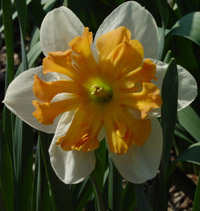
'Shrike' 11aW-P
Division 12 (Other Daffodil Cultivars)
Recommended Cultivars:
'Bittern' 12Y-O, 'Demitasse' 12 W-Y, 'Eaton Song' 12Y-O, 'Golden Quince' 12Y-Y, 'Oz' 12Y-Y, 'Toto' 12W-W
'Bittern' 12Y-O, 'Demitasse' 12 W-Y, 'Eaton Song' 12Y-O, 'Golden Quince' 12Y-Y, 'Oz' 12Y-Y, 'Toto' 12W-W
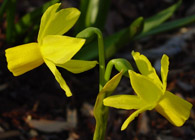
'Golden Quince' 12Y-Y
Division 13 (Species Daffodils)
Some species are well-known as southern heirloom daffodils. These tried and true daffodils like sun, water and neglect---they do not like annual fertilizing and will not bloom if you do. Standbys include: Narcissus pseudonarcissus, N. obvallaris, N. jonquilla, N. x intermedius, N. x odorus and N. x medioluteus. In general, N. pseudonarcissus prefers clay, while N. mochatus prefers a sandier soil. N. x tenuoir, N. x gracilis and N. x medioluteus prefer some afternoon shade, being poeticus hybrids. For N. jonquilla strains, in upper Zone 7 late strains will grow (such as "Pine Mills"), while only early strains ("Early Louisiana") are viable for Zone 8. Other species require conditions closer to their homeland; gardeners should ascertain requirements for these species before planting.
Some species are well-known as southern heirloom daffodils. These tried and true daffodils like sun, water and neglect---they do not like annual fertilizing and will not bloom if you do. Standbys include: Narcissus pseudonarcissus, N. obvallaris, N. jonquilla, N. x intermedius, N. x odorus and N. x medioluteus. In general, N. pseudonarcissus prefers clay, while N. mochatus prefers a sandier soil. N. x tenuoir, N. x gracilis and N. x medioluteus prefer some afternoon shade, being poeticus hybrids. For N. jonquilla strains, in upper Zone 7 late strains will grow (such as "Pine Mills"), while only early strains ("Early Louisiana") are viable for Zone 8. Other species require conditions closer to their homeland; gardeners should ascertain requirements for these species before planting.
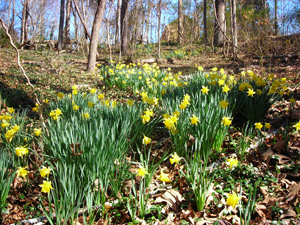
Narcissus pseudonarcissus in bloom at Woodburn Plantation, Pendleton, South Carolina, March 2008
Miniatures
The intricate world of miniature daffodils is not discussed at length in this article. [Most of the bulbocodium daffodils are considered miniatures.] A few of the tried and true include:
'Baby Moon' 7Y-Y, 'Baby Star' 7Y-Y, 'Bagatelle' 1Y-Y, 'Clare' 7Y-Y, 'Hawera' 5Y-Y, 'Jumblie' 12Y-O, 'Little Beauty' 1W-Y,* 'Little Gem' 1Y-Y, 'Minnow' 8W-Y, 'Mite' 6Y-Y, Narcissus jonquilla 13Y-Y, Narcissus wilkommii 13Y-Y, 'Picablano' 2W-W, 'Pixie's Sister' 7Y-Y, 'Segovia' 3W-Y, 'Small Talk' 1Y-Y, 'Snipe' 6W-W, 'Sundial' 7Y-Y, 'Sun Disc' 7Y-Y, 'Tanagra' 1Y-Y, 'Tete-a-Tete' 12Y-Y, 'Xit' 3W-W
* 'Little Gem' 1Y-Y is highly recommended by a North Carolina miniatures expert.
The intricate world of miniature daffodils is not discussed at length in this article. [Most of the bulbocodium daffodils are considered miniatures.] A few of the tried and true include:
'Baby Moon' 7Y-Y, 'Baby Star' 7Y-Y, 'Bagatelle' 1Y-Y, 'Clare' 7Y-Y, 'Hawera' 5Y-Y, 'Jumblie' 12Y-O, 'Little Beauty' 1W-Y,* 'Little Gem' 1Y-Y, 'Minnow' 8W-Y, 'Mite' 6Y-Y, Narcissus jonquilla 13Y-Y, Narcissus wilkommii 13Y-Y, 'Picablano' 2W-W, 'Pixie's Sister' 7Y-Y, 'Segovia' 3W-Y, 'Small Talk' 1Y-Y, 'Snipe' 6W-W, 'Sundial' 7Y-Y, 'Sun Disc' 7Y-Y, 'Tanagra' 1Y-Y, 'Tete-a-Tete' 12Y-Y, 'Xit' 3W-W
* 'Little Gem' 1Y-Y is highly recommended by a North Carolina miniatures expert.
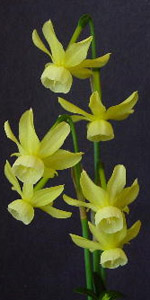
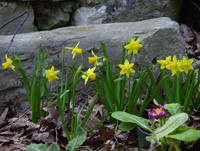
'Tete-a-Tete' 12Y-Y
'Hawera' 5Y-Y
DAFFODIL SOURCES
Brent and Becky's BulbsGloucester, Virginia
Old House GardensAnn Arbor, Michigan
The Southern Bulb CompanyTexas
Terra Ceia FarmsPantego, North Carolina
Wayside GardensHodges, South Carolina
Brent and Becky's BulbsGloucester, Virginia
Old House GardensAnn Arbor, Michigan
The Southern Bulb CompanyTexas
Terra Ceia FarmsPantego, North Carolina
Wayside GardensHodges, South Carolina
BIBLIOGRAPHY
Brent and Becky Heath, Daffodils for American Gardens (Washington: Elliott & Clark Publishing, 1995).
Scott Ogden, Garden Bulbs for the South (Dallas: Taylor Publishing Company, 1994).
Linda M. Van Beck and Sara L. Van Beck, Daffodils in Florida: A Field Guide to the Coastal South (independently published, 2004).
OTHER SOURCES
"Spring Flowering Bulbs," publication HGIC 1155, Clemson University
Brent and Becky Heath, Daffodils for American Gardens (Washington: Elliott & Clark Publishing, 1995).
Scott Ogden, Garden Bulbs for the South (Dallas: Taylor Publishing Company, 1994).
Linda M. Van Beck and Sara L. Van Beck, Daffodils in Florida: A Field Guide to the Coastal South (independently published, 2004).
OTHER SOURCES
"Spring Flowering Bulbs," publication HGIC 1155, Clemson University
Author: Sara Van Beck. Published June 8, 2008.
Copyright
Southern Edition
All Rights Reserved
Southern Edition
All Rights Reserved
All materials contained on this site, including text and images, are protected by copyright laws and may not be reproduced without prior written permission from the publisher. Where applicable, use of some items contained on this site may require permission from other copyright owners.
Fair Use of text from SouthernEdition.com is permitted to the extent allowed by copyright law. Proper citation is requested. Please use this guide when citing a Southern Edition article.
Contact Greg Freeman or SouthernEdition.comFair Use of text from SouthernEdition.com is permitted to the extent allowed by copyright law. Proper citation is requested. Please use this guide when citing a Southern Edition article.